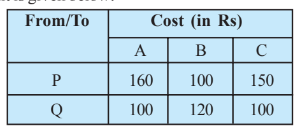Complete Solutions to SOLVED EXAMPLES of chapter LINEAR PROGRAMMING of Class 12 book with complete answers and questions
| Class 12 | MATHS |
| Chapter | LINEAR PROGRAMMING |
| Mathematics | SOLVED EXAMPLES |
| Number Of Questions | 11 |
| Academic Year | 2023-24 |
(Transportation problem) There are two factories located one at place P and the other at place Q. From these locations, a certain commodity is to be delivered to each of the three depots situated at A, B and C. The weekly requirements of the depots are respectively 5, 5 and 4 units of the commodity while the production capacity of the factories at P and Q are respectively 8 and 6 units. The cost of transportation per unit is given below :

How many units should be transported from each factory to each depot in order that the transportation cost is minimum. What will be the minimum transportation cost?08:45View Solution(Manufacturing problem) A manufacturer has three machines I, II and III installed in his factory. Machines I and II are capable of being operated for at most 12 hours whereas machine HI must be operated for atleast 5 hours a day. She produces only two items M and N each requiring the use of all the three machines. The number of hours required for producing 1 unit of each of M and N on the three machines are given m the following table:She makes a profit of Rs 600 and Rs 400 on items M and N respectively. How many of each item should she produce so as to maximise her profit assuming that she can sell all the items that she produced? What will be the maximum profit?
08:39View Solution(Manufacturing problem) `A` manufacturing company makes two models `A` and `B` of a product. Each piece of Model `A` requires `9` labour hours for fabricating and 1 labour hour for finishing. Each piece of Model `B` requires `12` labour hours for fabricating and `3` labour hours for finishing. For fabricating and finishing, the maximum labour hours available are `180` and `30` respectively. The company makes a profit of Rs 8000 on each piece of model A and Rs 12000 on each piece of Model B. How many-pieces of Model A and Model B should be manufactured per week to realise a maximum profit? What is the maximum profit per week?
11:56View Solution(Diet problem) A dietician has to develop a special diet using two foods P and Q. Each packet (containing 30 g) of food P contains 12 units of calcium, 4 units of iron, 6 units of cholesterol and 6 units of vitamin A. Each packet of the same quantity of food Q contains 3 units of calcium, 20 units of iron, 4 units of cholesterol and 3 units of vitamin A. The diet requires atleast 240 units of calcium, atleast 460 units of iron and at most 300 units of cholesterol. How many packets of each food should be used to minimise the amount of vitamin Am the diet? What is the minimum amount of vitamin A?
12:50View SolutionSolve the following linear programming problem graphically :Minimise `Z = 200 x + 500 y`. . . (1)subject to the constraints:`x+2ygeq10` . . .(2)`3x+4ylt=24` . . .(3)`xgeq0,ygeq0` . . .(4)
09:10View SolutionSolve the following problem graphically:Minimise and Maximise `Z = 3x + 9y` . . . (1)subject to the constraints: `x+3ylt=60` . . . (2) `x+ygeq10` . . . (3) `xlt=y` . . . (4) `xgeq0,ygeq0` . . . (5)
06:00View SolutionSolve the following linear programming problem graphically: Maximise `Z = 4x +y` . . . (1) , subject to the constraints:`x+ylt=50` . . .(2), `3x+ylt=90` . . .(3) , `xgeq0,ygeq0` . . .(4)
08:15View Solution(Diet problem): A dietician wishes to mix two types of foods in such a way that vitamin contents of the mixture contain atleast 8 units of vitamin A and 10 units of vitamin C. Food I contains 2 units/kg of vitamin A and 1 unit/kg of vitamin C. Food II contains 1 unit/kg of vitamin A and 2 unite/kg of vitamin C. It costs Rs 50 per kg to purchase Food T and Rs 70 per kg to purchase Food II. Formulate this problem as a linear programming problem to minimize the cost of such a mixture.
07:09View Solution(Allocation problem) A cooperative society of farmers has 50 hectare of land to grow two crops X and Y. The profit from crops X and Y per hectare are estimated as Rs 10,500 and Rs 9,000 respectively. To control weeds, a liquid herbicide has to be used for crops X and Y at rates of 20 litres and 10 litres per hectare. Further, no more than 800 litres of herbicide should be used in order to protect fish and wild life using a pond which collects drainage from this land. How much land should be allocated to each crop so as to maximise the total profit of the society?
06:24View SolutionDetermine graphically the minimum value of the objective function`Z = - 50 x + 20 y` . . .(1)subject to the constraints:`2x-ygeq-5` . . .(2)`3x+ygeq3` . . .(3)`2x-3ylt=12` . . .(4)`xgeq0,ygeq0` . . .(5)
10:23View SolutionMinimise `Z = 3x + 2y` subject to the constraints:
`x+yge8` . . .(1)
`3x+5ylt=15` . . .(2)
`xgeq0,ygeq0` . . .(3)03:57View Solution
SOLVED EXAMPLES questions and complete solutions for chapter LINEAR PROGRAMMING of NCERT MATHEMATICS(HINGLISH) of Class 12
